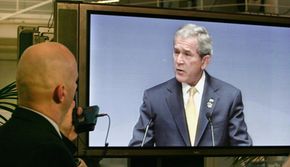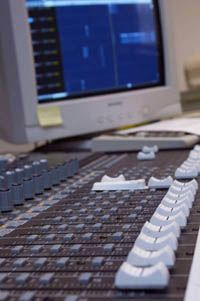A multiparty conference call is one in which there are multiple presenters in different locations.
You can use microphones when recording multiparty conference calls, but it can get a little complicated. You have to set microphones at all the different locations to record all the presenters individually. Then you have to take those recordings and paste them together using audio editing software. The result will be a high-quality recording, but will require considerable time and energy.
The most common method for recording multiparty conference calls is to use a simple phone adapter called a Telephone Recording Control that captures the audio from the phone call and routes it into a cassette recorder, a digital recorder or straight into a computer.
Here's how the phone adapter works:
- Plug the phone line from the wall into the adapter
- Plug your phone into the other side of the adapter
- Plug the adapter's audio out cord into your cassette recorder, digital recorder or computer
The advantage of using a phone adapter to record multiparty conference calls is that the adapter itself is inexpensive (around $15 to $20) and easy to set up.
A digital hybrid is a small audio mixer especially made for phone conversations. It has jacks for phone lines and dials for adjusting audio levels so that recorded phone conversations come out sounding natural and balanced [source: BSW].
As we mentioned in the introduction to this article, probably the most common way to record a multiparty conference call is to have your conference call service do it for you. Most conference call services allow the moderator to press a key on his phone to start recording the conversation. You can also choose to record all calls by default.
The recorded call will remain on the conference call system for a specified amount of days or it can be e-mailed to the moderator and/or participants as a digital audio file like WAV or MP3.
As for the future of recording conference calls, more and more people are turning to cheap or free VoIP conference call recording solutions like Pamela for Skype. While others are using traditional conference call technology to solve new problems.
Chris Pirillo, host of a popular online videocast, has started to experiment with conference calls as a solution for handling call-in questions. Pirillo has had callers dial into a conference call with a special pin and press "9" to raise their hands with a question. A conference call operator then screens each caller to find out what they're going to ask [source: Chris Pirillo].
But Pirillo sees more in this than simply organizing his question queue. Recording these conference calls can become a powerful way to archive and tag useful content. Once a question is asked and answered on air, one of his producers can take that recorded chunk of audio, tag it with relevant information about the content of the question and post it to other Web sites and news feeds as standalone content [source: Chris Pirillo]. Someone searching for information about how to record a conference could find Pirillo's audio answer online and the rest is history.
For more information about recording conference calls and related topics, check out the links on the next page.



